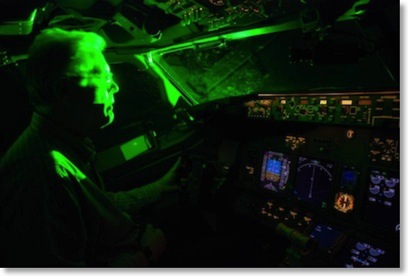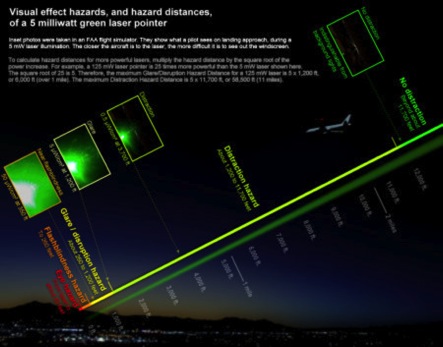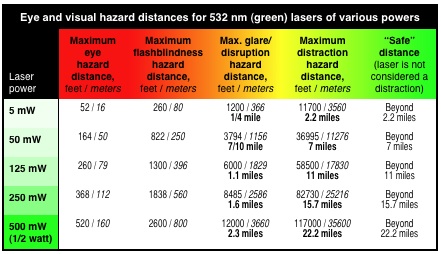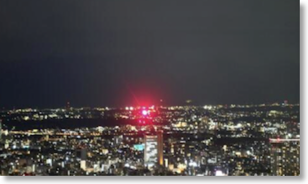LaserPointerSafety.com
A comprehensive resource for safe and responsible laser use
What makes lasers hazardous to aviation
Visual interference with pilots
Safety experts are primarily concerned with visible lasers causing potential “visual interference” with pilot performance during critical phases of flight. They have identified these three hazards:
- Temporary flashblindness. Like a camera flash directly in one’s eyes — the pilot is temporarily unable to see until the afterimage fades.
- Glare and disruption. The pilot cannot see past the light glare, until the light stops. The glare is bright enough to disrupt normal operations.
- Distraction. The pilot is distracted by the steady or flashing laser light, that is significantly brighter than other nighttime sources such as city lights and airport marker lights. While not technically a “visual” interference — the pilot can see despite the light — the light distraction can interfere with mental awareness. This can be overcome by education and training in laser hazards and how to react to them.
But when a pilot is flashblinded on final approach, the situation can be very dangerous. This is especially hazardous because even a low-powered “legal” laser pointer (5 milliwatts power, 1 milliradian divergence, green color) can be a distraction at a distance of two miles. Obviously, more powerful lasers are of even greater concern.
As of July 1 2016, pilots have reported over 42,000 laser illuminations to the U.S. Federal Aviation Administration and the U.K. Civil Aviation Authority, since 2004. The most severe impact on flights thus far have been a British Airways flight which was aborted after an hour, and numerous police and rescue missions which were cut short. However, one can imagine a scenario where laser interference with flight operations happens at a critical time, and becomes the proverbial “straw that breaks the camel’s back,” causing a serious accident.

FAA public domain photo illustrating what laser illumination of a cockpit can look like. Because the beam usually cannot be held steady on the cockpit, pilots experience one or more flashes as the beam crosses the windscreen. An animation on this page illustrates the effect. The FAA’s highest-resolution version of the above photo is here.
Note that visual interference happens only when the laser emits visible light. Also, because the eye is more sensitive to green light, a laser emitting green light will cause more visual interference than a laser of equal power emitting a red or blue beam. This and other basic principles of laser hazards are discussed on this page.
Potential eye injury
Laser and aviation experts also consider the potential for eye injury to pilots (or anyone onboard looking out a window when laser light enters):
- Eye hazard. The laser’s light could be powerful enough to cause temporary or permanent damage to pilots’ eyes. Eye damage can be caused by visible, infrared or ultraviolet laser light.
A 2016 in-depth study by three top U.K. laser safety experts concluded that lasers aimed at aircraft have not caused eye injuries, and are not likely to do so. On March 19 2015, an FAA spokesperson told LaserPointerSafety that “The FAA is unaware of any U.S. commercial pilot who has suffered permanent eye damage as a result of exposure to laser light when in the cockpit.” There was one report in the U.K. of a pilot who claimed to be injured, but experts doubt his eye troubles were due to laser exposure.
Note that eye injury can occur from any type of laser beam: visible or invisible (infrared, ultraviolet).
A 5 milliwatt laser: a distraction 2 miles away
In the United States, lasers sold for pointing uses cannot exceed 5 mW. The diagram below shows the hazard distances for a 5 milliwatt “U.S. legal” green laser pointer with a 1 milliradian beam divergence:
- It is a potential eye hazard from the pointer to about 52 feet.
- It is a temporary flashblindness hazard from the pointer, out to about 260 feet. On the diagram, this is illustrated in the inset photo “Near-flashblindness” which shows what a 5 mW laser looks like at 350 feet.
- It is causes glare and is a disruption hazard from about 260 feet to about 1,200 feet. This is shown in the “Glare” inset photo where the runway is not visible.
- It is a distraction hazard from the pointer to over two miles (11,700 feet). The distraction can be dangerous during a critical phase of flight, such as takeoffs and landings. Note that this is not truly “visual” interference, since a pilot can see despite the light. Instead, it is a mental distraction, interfering with the pilot’s attention. This can be overcome if a pilot is aware of laser hazards, and how to react to them (e.g., ignoring low-level laser distractions).
The laser’s light is not truly safe until it is indistinguishable from background lights on the ground. A pilot may notice a flashing dot of light, but it should not be enough to cause a distraction. (This does not mean that anyone should aim a 5 mW laser at a plane if it is over 2 miles away. For one thing, it is very difficult to gauge aircraft distances at night. Even more important, there simply is no reason to aim a laser at an aircraft except in an emergency situation such as a wilderness rescue.)

Click on the diagram for a larger version
For more info on the inset photos (cockpit views of laser light), see the “2004 FAA simulator” page
A 125 milliwatt laser: a distraction 11 miles away
More powerful lasers are hazardous at greater distances. The hazard distance increases as the square root of the power increase.
For example, a 125 mW laser is 25 times more powerful than a 5 mW laser. The square root of 25 (the power increase) is 5 (the hazard distance increase). Therefore, multiply the hazard distances for a 5 mW laser by 5, to find the hazard distances for a 125 mW laser. For example, if a 5 mW laser is an eye hazard out to 52 feet, a 125 mW laser is an eye hazard out to 5*52 or 164 feet.
The table below does the multiplications for you. It provides some sample laser powers and the corresponding hazard distances measured from the laser output. (Note that these distances are approximations. It is not as if a 5 mW laser is an eye hazard at 52 feet but is not an eye hazard at 53 feet. The distances give approximations where one hazard zone shades into another.)

Click on the table for a larger version showing additional data
Laser light is visible at great distances
Here is a photo showing how a 1 milliwatt laser is visible at a distance of 20 kilometers (12 miles) across Tokyo. Although the laser’s irradiance is below the FAA distraction limit of 50 nanowatts per sq. cm. -- it is approximately as bright as other city lights -- you can see that the light is still visible.

How to be safe when using lasers at night
If you absolutely must point something out in the night sky (e.g., at a star party), use the laser to circle the object -- don’t aim directly at it. Additional suggestions are on the Tips for star pointing page.
Additional information
- For the FAA’s viewpoint, see the 2009 FAA/Air Force aircraft laser illumination video, and the 2010 FAA publication “Laser Hazards in Navigable Airspace”, also known as “Medical Facts for Pilots” (AM-400-10/3).
- Studies from the FAA and others are in the “Info & studies from FAA etc...” section of this website.
- Articles from other aviation sources, and presentations to laser safety groups, are on the Links page.